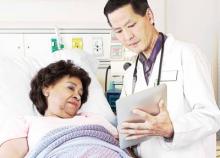Sued If You Do, Sued If You Don’t
A 52-year-old woman presented to the ED with complaints of abdominal pain, vaginal bleeding, and left leg pain. The patient stated that the symptoms, which she had been experiencing over the past few days, were becoming progressively worse. She denied fevers, chills, nausea, vomiting, diarrhea, or constipation. Her surgical history was
remarkable for an appendectomy 30 years prior. The patient was not currently on any medications. Regarding social history, she denied alcohol or tobacco use. She also denied any allergies to medications.
On physical examination, all of the patient’s vital signs were normal. The head, eyes, ears, nose, and throat, and lung and heart examinations were also normal; however, on abdominal examination, she exhibited tenderness throughout the lower abdomen, but without guarding or rebound. There was no costovertebral angle tenderness of the back. The pelvic examination was remarkable for a small amount of blood from the cervical os and a slightly enlarged uterus. The adnexa were normal and without tenderness.
The emergency physician (EP) ordered a complete blood count, basic metabolic profile, and urinalysis. An intravenous (IV) catheter was placed, and the patient was administered an IV analgesic and antiemetic. A normal saline drip of 125 cc per hour was also ordered. In view of the abdominal pain and tenderness, the EP ordered a computed tomography (CT) scan of the abdomen and pelvis with IV contrast. Within a few minutes of receiving the IV contrast, the patient experienced a sharp increase in blood pressure, followed by an abrupt change in mental status. A stat noncontrast head CT scan revealed a subarachnoid hemorrhage (SAH), and a CT angiogram (CTA) of the head revealed a ruptured cerebral aneurysm. Although the patient was taken immediately to the operating room by neurosurgery services, she had permanent left-sided weakness; as a result, she was no longer able to perform her previous type of work.The patient sued both the EP and the hospital, claiming that the CT scan was unnecessary and had it not been performed, she would not have experienced the stroke. The defense asserted that the CT scan with contrast was appropriate given the patient’s symptoms and physical findings, and that the contrast dye used was not the cause of the stroke. The jury awarded the plaintiff $3.6 million.
Discussion
This case is unique in that the EP was sued for ordering a CT scan. In the overwhelming majority of malpractice cases, EPs are sued for not obtaining a certain test—frequently a CT scan. It does not appear the jury in this case was correct in their judgment as there was no conceivable way the EP could have anticipated this type of unusual reaction, especially in a patient with no history of medication allergies.
This jury ruling places EPs in an untenable situation: If they order a test and anything bad happens, they will be sued. If they do not order a test and something bad happens, they will be sued. In legal theory, there must be proximal cause between what the physician did (ie, order the CT scan) and the bad outcome, or negligence (ie, SAH). For this case, the two events seem true-true and unrelated. The contrast dye clearly did not cause the cerebral aneurysm, which was a preexisting condition.
Emergency physicians are very familiar with the contraindications for obtaining studies with IV contrast dye. The most important concern is for some type of adverse reaction to the iodinated contrast media (ICM). While such reactions are typically lumped under “allergy,” this term is actually incorrect. Rather, two types of reactions can occur following exposure to ICM: idiosyncratic (more common) and nonidiosyncratic.1 A more accurate description of the idiosyncratic reaction is anaphylactoid. This type of reaction occurs within a few minutes of exposure, and no previous sensitization is necessary. Symptoms are classified as mild, moderate, or severe (Table).Nonidiosyncratic reactions are due to direct toxic or osmolar effects. Symptoms include bradycardia, hypotension, vasovagal reactions, sensation of warmth, metallic taste in the mouth, and nausea and vomiting.1
Ironically, the majority of adverse reactions to ICM involve hypotension, not hypertension. This includes cardiovascular reactions to ICM, which typically involve bradycardia, peripheral vasodilation, and hypotension.1 The incidence and severity of an adverse reaction to ICM also depends on whether ionic or nonionic ICM was used. (Unfortunately, the type of ICM administered to the patient in this case was not disclosed.)
The incidence and severity of adverse reactions to ICM are less with nonionic compared to ionic ICM. More than 90% of adverse reactions to nonionic ICM are anaphlyactoid.2 In general, adverse reactions occur in 4% to 12% of patients receiving ionic ICM compared to 1% to 3% of those receiving nonionic ICM.2 In a study of more than 300,000 contrast administrations, Katayama et al,3 found the overall risk for severe adverse reaction to be 0.2% for ionic ICM compared to 0.04% for nonionic ICM.


